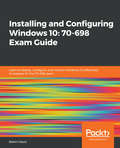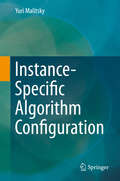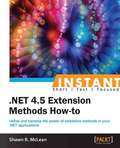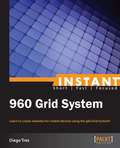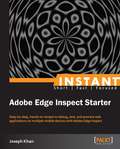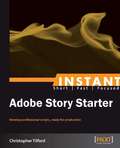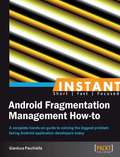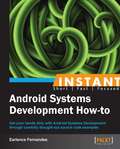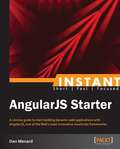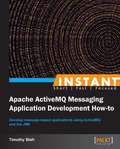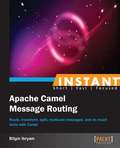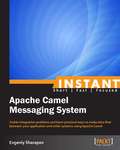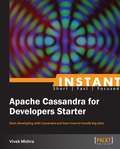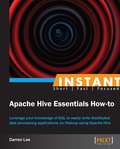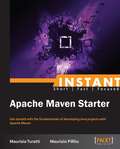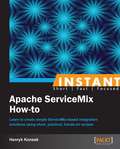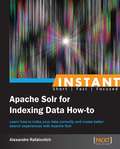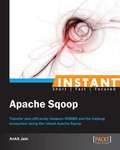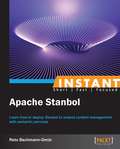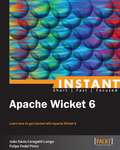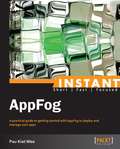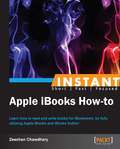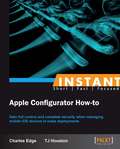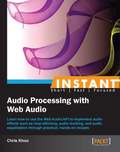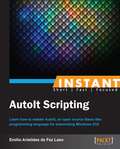- Table View
- List View
Installing and configuring Windows 10: 70-698 Exam Guide
by Bekim DautiThis book is for IT professionals who perform installation, configuration, general local management and maintenance of Windows 10 core services. Also, this book may mention some enterprise scenarios or cloud-integrated services.
Instance-Specific Algorithm Configuration
by Yuri MalitskyThis book presents a modular and expandable technique in the rapidly emerging research area of automatic configuration and selection of the best algorithm for the instance at hand. The author presents the basic model behind ISAC and then details a number of modifications and practical applications. In particular, he addresses automated feature generation, offline algorithm configuration for portfolio generation, algorithm selection, adaptive solvers, online tuning, and parallelization. The author's related thesis was honorably mentioned (runner-up) for the ACP Dissertation Award in 2014, and this book includes some expanded sections and notes on recent developments. Additionally, the techniques described in this book have been successfully applied to a number of solvers competing in the SAT and MaxSAT International Competitions, winning a total of 18 gold medals between 2011 and 2014. The book will be of interest to researchers and practitioners in artificial intelligence, in particular in the area of machine learning and constraint programming.
Instant .NET 4.5 Extension Methods How-to
by Shawn R. McleanFilled with practical, step-by-step instructions and clear explanations for the most important and useful tasks.The book is packed with quick recipes on creating and extending extension methods in your .NET applications.This book is for developers in C# and the .NET framework, with a basic understanding of language syntax and OOP concepts. Readers are expected to have some experience in finding their way around Visual Studio.
Instant 960 Grid System
by Diego TresGet to grips with a new technology, understand what it is and what it can do for you, and then get to work with the most important features and tasks. Instant 960 Grid System uses step-by-step instructions, covering the basic understanding needed to create a quick, high quality responsive website prototype using the 960 Grid System.The book is intended for beginner web developers and information architects looking to create a quick responsive website prototype. Basic knowledge of web development and a little understanding of grids is encouraged.
Instant Adobe Edge Inspect Starter
by Joseph KhanGet to grips with a new technology, understand what it is and what it can do for you, and then get to work with the most important features and tasks. This easy-to-understand Starter guide will get you up to speed with Adobe Edge Inspect quickly and with little effort.This book is for frontend web developers and designers who are developing and testing web applications targeted for mobile browsers. It's assumed that you have a basic understanding of creating web applications using HTML, CSS, and JavaScript, as well as being familiar with running web pages from local HTTP servers. Readers are also expected to have a basic knowledge of debugging web applications using developer tools such as the Chrome web inspector. And of course you need some mobile devices for running the example in this book and testing it.
Instant Adobe Story Starter
by Christopher TilfordIf you're keen to get started writing your own scripts, then you should be able to pick up this essential guide and get creative right away! No prior experience is required, as this is open to all skill levels. If you've always wanted to write scripts for a variety of different creative mediums like film and television, but are unsure of what the industry is looking for when it comes to formatting requirements, then this book is for you.
Instant Android Fragmentation Management How-to
by Gianluca PacchiellaWritten in the easy to understand Packt How-to format, this book offers the solution to the big issues in Android application development. If you want the best possible reviews for your apps, regardless of device or Android operating system, then this book is for you.
Instant Android Systems Development How-to
by Earlence FernandesFilled with practical, step-by-step instructions and clear explanations for the most important and useful tasks.This is a how-to book with practical, coded examples which are well explained.This book is for seasoned Android SDK programmers. Knowledge of Java, Linux, and C is assumed. Certain Operating System concepts like processes, threads, shared memory, and inter process communication is also assumed, but the book provides necessary background before any obscure topics are introduced.
Instant AngularJS Starter
by Dan MenardGet to grips with a new technology, understand what it is and what it can do for you, and then get to work with the most important features and tasks. This book is written in an easytoread style, with a strong emphasis on realworld, practical examples. Stepbystep explanations are provided for performing important tasks.This book is for web developers familiar with JavascriptIt doesn't cover the history of AngularJS, and it's not a pitch to convince you that AngularJS is the best framework on the entire web. It's a guide to help you learn everything you need to know about AngularJS in as few pages and with as many examples as possible.
Instant Apache ActiveMQ Messaging Application Development How-to
by Timothy BishFilled with practical, step-by-step instructions and clear explanations for the most important and useful tasks.This is a Packt Instant How-to guide, which provides concise and practical recipes to help you get started writing applications with ActiveMQ using practical examples.Instant ActiveMQ Application Development How-to is for the developers who are new to Java Message Service application development or new to JMS development using ActiveMQ. Readers will come away ready to solve complicated messaging related problems using the JMS API and ActiveMQ.
Instant Apache Camel Message Routing
by Bilgin IbryamFilled with practical, step-by-step instructions and clear explanations for the most important and useful tasks. This short, instruction-based guide shows you how to perform application integration using the industry standard Enterprise Integration Patterns.This book is intended for Java developers who are new to Apache Camel and message- oriented applications.
Instant Apache Camel Messaging System
by Evgeniy SharapovGet to grips with a new technology, understand what it is and what it can do for you, and then get to work with the most important features and tasks. A beginner's guide to Apache Camel that walks you through basic operations like installation and setup right through to developing simple applications.This book is a good starting point for Java developers who have to work on an application dealing with various systems and interfaces but who haven't yet started using Enterprise System Buses or Java Business Integration frameworks.
Instant Apache Cassandra for Developers Starter
by Vivek MishraGet to grips with a new technology, understand what it is and what it can do for you, and then get to work with the most important features and tasks.A concise and example driven book that will help you in transitioning from beginner to Cassandra skilled developer.Instant Apache Cassandra for Developers Starter is a must-read if you want to learn how to leverage Cassandra to create powerful big data solutions. For the examples in the book you should have a basic familiarity with Java, and be able to implement and run Java applications as well as basic UNIX commands.
Instant Apache Hive Essentials How-to
by Darren LeeFilled with practical, step-by-step instructions and clear explanations for the most important and useful tasks.This book provides quick recipes for using Hive to read data in various formats, efficiently querying this data, and extending Hive with any custom functions you may need to insert your own logic into the data pipeline.This book is written for data analysts and developers who want to use their current knowledge of SQL to be more productive with Hadoop. It assumes that readers are comfortable writing SQL queries and are familiar with Hadoop at the level of the classic WordCount example.
Instant Apache Maven Starter
by Maurizio Pillitu Maurizio TurattiGet to grips with a new technology, understand what it is and what it can do for you, and then get to work with the most important features and tasks.The book follows a starter approach for using Maven to create and build a new Java application or Web project from scratch.Instant Apache Maven Starter is great for Java developers new to Apache Maven, but also for experts looking for immediate information. Moreover, only 20% of the necessary information about Maven is used in 80% of the activities. This book aims to focus on the most important information, those pragmatic parts you actually use on a daily basis.
Instant Apache ServiceMix How-to
by Henryk KonsekFilled with practical, step-by-step instructions and clear explanations for the most important and useful tasks.Practical, step-by-step, recipe-based approach.This publication is dedicated to Java software engineers interested in messaging solutions and system integration. The book assumes that you already know the Java programming language and the basics of the OSGI specification.The book focuses on deployment issues related to the latter technologies and possible solutions to them based on the ServiceMix container.
Instant Apache Solr for Indexing Data How-to
by Alexandre RafalovitchFilled with practical, step-by-step instructions and clear explanations for the most important and useful tasks. This book is written in a friendly, practical manner with recipes covering important indexing techniques and methods using Apache Solr.This book is for developers who want to dive deeper into Solr. Regardless of whether you are just starting with Solr or have already built your first collection by copying and modifying examples, this book will take you through the complicated steps of indexing your data with Solr.
Instant Apache Sqoop
by Ankit JainFilled with practical, step-by-step instructions and clear explanations for the most important and useful tasks. Instant Apache Sqoop is full of step-by-step instructions and practical examples along with challenges to test and improve your knowledge.This book is great for developers who are looking to get a good grounding in how to effectively and efficiently move data between RDBMS and the Hadoop ecosystem. It's assumed that you will have some experience in Hadoop already as well as some familiarity with HBase and Hive.
Instant Apache Stanbol
by Reto Bachmann-GmurFilled with practical, step-by-step instructions and clear explanations for the most important and useful tasks. Instant Apache Stanbol How-to will enable you to become an expert in content management with semantics at the core, with the help of practical recipes. Instant Apache Stanbol How-to is for Java developers who would like to extend Stanbol or would just like to use Stanbol without caring about its internals. A few recipes that show how to extend Stanbol require some familiarity with Java and JavaScript.
Instant Apache Wicket 6
by Felipe Fedel Pinto Joao Savio LongoGet to grips with a new technology, understand what it is and what it can do for you, and then get to work with the most important features and tasks. This Starter style guide takes the reader through the basic workflow of Apache Wicket in a practical and friendly style.Instant Apache Wicket 6 is for people who want to learn the basics of Apache Wicket 6 and who already have some experience with Java and object-oriented programming. Basic knowledge of web concepts like HTTP and Ajax will be an added advantage.
Instant AppFog
by Pau Kiat WeeGet to grips with a new technology, understand what it is and what it can do for you, and then get to work with the most important features and tasks. This easy to follow, hands-on guide shows you how to deploy and manage your application within minutes.Instant AppFog Starter is great for developers who are new to AppFog and who are primarily working on code rather than infrastructure. This book is perfect for those who are looking to publish applications without an in-depth knowledge of servers, firewalls, and networking. It is assumed that you will have some experience of web development as well as basic command line usage.
Instant Apple iBooks How-to
by Zeeshan ChawdharyFilled with practical, step-by-step instructions and clear explanations for the most important and useful tasks. Get the job done and learn as you go. Written in a step-by-step tutorial style, this book shows you in simple steps how to get the most from your iBooks experience.This book is for literary geeks who want to explore the Apple iBooks universe. From buying books from the Apple iBookstore to organizing books and PDFs, this book goes forward by explaining how to write an interactive book with iBooks Author.
Instant Apple iOS Configuration Utility How-to
by Charles Edge Tj HoustonFilled with practical, step-by-step instructions and clear explanations for the most important and useful tasks. Get the job done and learn as you go. A how-To book with practical recipes accompanied with rich screenshots for easy comprehension.This book follows the Packt How-to approach, offering an informative yet practical guide that is easy to understand. The book takes a meticulous approach to providing quick and simple recipe-based solutions for security and deployment of iOS devices."Instant Apple iOS Configurator Utility How-to" book is ideal for anyone with a working knowledge in iOS device deployment and management. It is likely you will be responsible for the maintenance and security of iOS devices, ranging anywhere from 10 to 10,000. This is the ultimate guide to iOS security management and device deployment.
Instant Audio Processing with Web Audio
by Chris KhooFilled with practical, step-by-step instructions and clear explanations for the most important and useful tasks. A concise, recipe-based approach to use Web Audio's automation functionality to produce interesting audio effects such as audio stitching and ducking.This book is designed for developers with some HTML and JavaScript programming experience who are seeking to learn about Web Audio. Experience with AJAX and web server installation/configuration is a plus but is not a necessity in order to follow the content of the book.
Instant AutoIt Scripting
by Emilio Aristides LasoFilled with practical, step-by-step instructions and clear explanations for the most important and useful tasks. This is a Packt Instant How-to guide, which provides concise and clear recipes for getting started with AutoIt.Instant AutoIt Scripting Essentials How-to is for beginners who wish to know more about automation and programming, system administration developers who intent to automate/manage clusters and servers, and for computer programmers who want to control any PC to create seamless automation apps.
